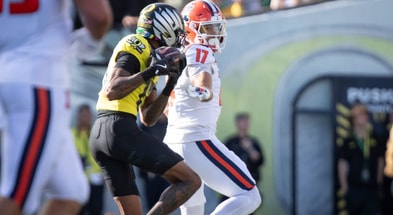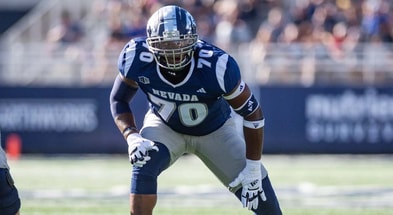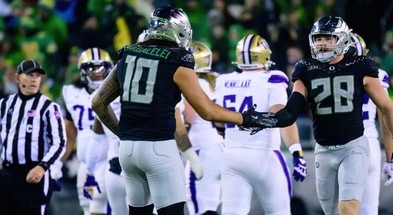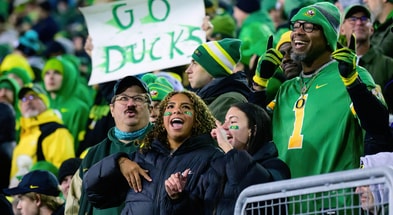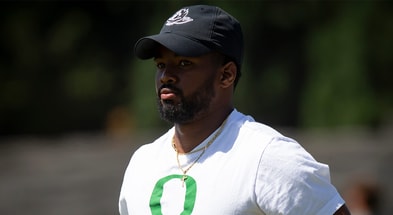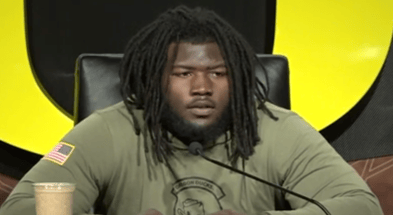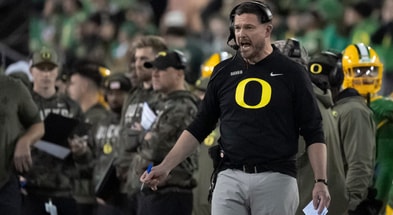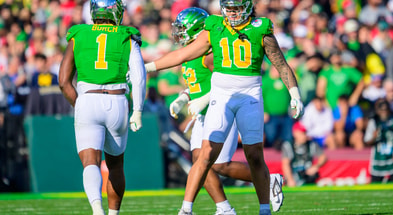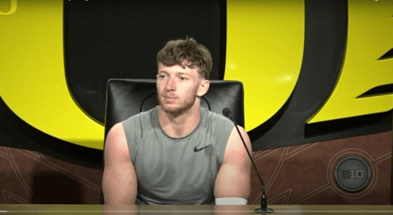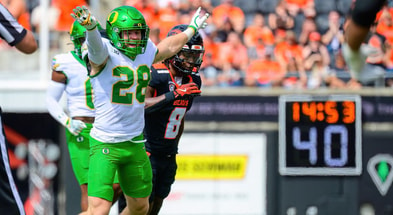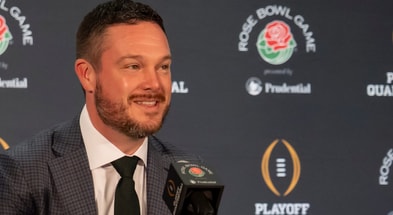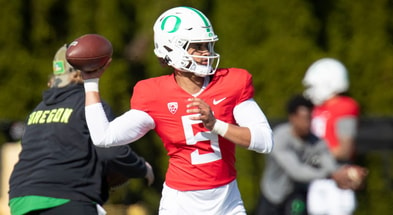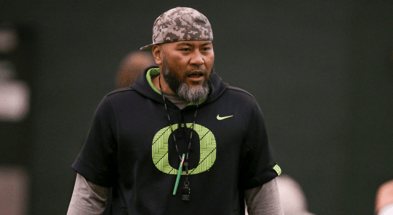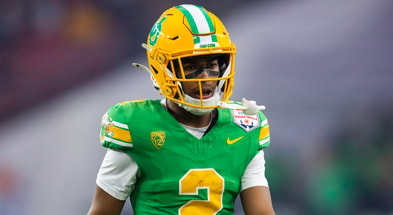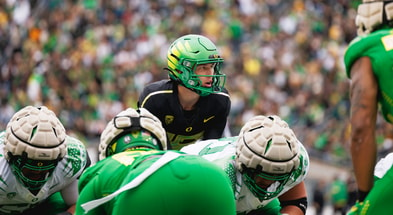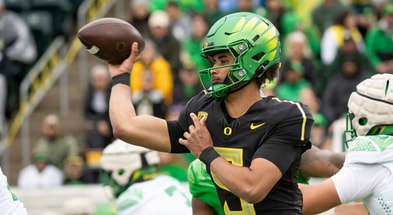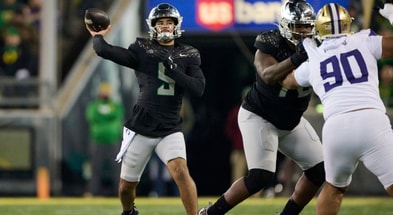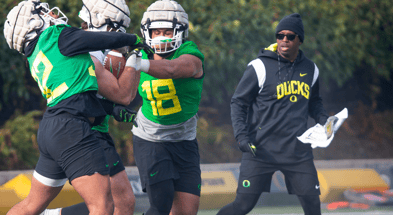Everything Commissioner George Kliavkoff said during Pac-12 Media Day

With the 2023 college football season right around the corner, the Pac-12 kicked off its annual conference media day Friday morning in Las Vegas.
Conference commissioner George Kliavkoff began the day with a press conference that spanned approximately 20 minutes. Here is a transcript of everything he said regarding conference media rights, expansion, and a flurry of other topics.
Related: Biggest Oregon-centric questions ahead of Pac-12 Media Day
Opening statement
“Good morning and welcome to the 2023 Pac-12 Media Day. Thank you all for being here today. We’re excited to be hosting this event in Las Vegas, home of our football championship game the last two years and longtime host of our men’s and women’s basketball tournaments. We are joined today by 11 of our highly accomplished head football coaches, along with the defensive coordinator of Colorado, and 24 of our incredible student-athletes.
I know I speak for the entire football community in sending out our thoughts to Coach Prime following his surgery earlier this week. We wish him a speedy and full recovery. Each one of our head coaches and student-athletes possesses great talent and leadership on and off the field. I know you and our fans across the country will enjoy the opportunity that today presents to get to know them and their personal stories better.
I think it’s fair to say this is the most highly anticipated Pac-12 Media Day in recent memory, first and foremost because of the strength of our football programs and the opportunity our teams have to compete for CFP invitations and the national championship this season. At the same time, I’m guessing a few of our media friends might have an interest in other topics related to the Pac-12 and might even have a question or two on those topics.
I’ll keep my remarks relatively brief, then I’ll take questions on the issues other than football before welcoming the chair of our athletic directors’ group, Mark Harlan of Utah, and Merton Hanks, the Pac-12’s executive associate commissioner of football, to help us refocus on the football season ahead.
Speaking of football, the Pac-12 is the strongest it has been in two decades. This is a direct result of the investments made by our schools and their athletic departments, particularly over the past few years. We have nationally recognized head coaches, both returning and new to the conference, with track records of great success.
We have an incredibly strong returning class of football student-athletes, highlighted by the most elite group of quarterbacks of any conference in the country and highly touted incoming recruits. Our conference boasts elite teams capable of competing for the CFP and national championship, and great depth up and down our league. Last season was our best in recent memory. I’ll share a few data points.
Last year the Pac-12 had five teams finish with 10 or more wins for only the second time in Pac-12 history. We were the only conference to achieve this milestone in 2022, and the first Power Five conference to do so since 2019. We had six schools finish in both the final AP top 25 and the final CFP rankings, marking the first time the Pac-12 has achieved this milestone since 2014. We had five of the top 11 teams in scoring offense. We had eight quarterbacks throw for 3,000 yards last season, tied for the most in college football history. Six of those eight quarterbacks return this season, and all six of them are here with us today. You’re going to get to meet them. We have the reigning Heisman Trophy winner returning to a Pac-12 school for the first time since 2005 and have several of the most highly touted challengers for the Heisman.
25 of the 51 players selected All-Pac-12 first and second team last year return to the Pac-12 this year, the highest percentage among the Power Five. Among these returning players are both the Pac-12’s first and second-team quarterbacks, three of the five first and second-team wide receivers, six of the eight first and second-team defensive linemen, and three of the top five returning running backs in rushing yards. We have five schools in the top 25 in recruiting rankings.
The most schools in the top 25 for the Pac-12 since 2017. We have four schools in the top 10 of the transfer portal rankings. We have six 5-star recruits, the most since 2017, including keeping five of the six 5-star recruits at home on the West Coast. You’ll recall that keeping the best West Coast high school players in our footprint and at our schools was part of the goals we set a few years back.
“It’s worth noting that our success last season translated into more viewership with our ABC, ESPN, ESPN-2 and FOX Pac-12 football ratings all up between 19 and 21% year over year. Our Pac-12 football championship game recorded the highest viewership numbers in its history, along with a sellout crowd. We have a lot of reasons to feel optimistic about the upcoming season of Pac-12 football.
The imminent expansion of the College Football Playoffs from four to twelve teams is a great reminder of what’s ultimate objective is for any conference or football program to qualify for the CFP and win a national championship. The Pac-12 will be in a great position to reap the benefits of this exciting new format. I am pleased that during the lunch hour on this stage, we will have a special Q&A on the topic of the College Football Playoffs with Bill Hancock, executive director of the CFP; Rick George, athletic director at Colorado who just left the CFP Selection Committee; and Rob Mullens, athletic director at the University of Oregon and former chair of the CFP Selection Committee. I’m looking forward to hearing Bill, Rick, and Rob talk about the expanded CFP.
While today is about football, I’d be remiss if I did not acknowledge the Pac-12’s continued dominance in other sports. Our universities are focused on broad-based sports programming, and our Pac-12 schools won nine NCAA titles this past season, marking the 18th consecutive year that the Pac-12 has won or tied for the most NCAA titles. In addition, the Directors’ Cup returned to its rightful home in the Pac-12 after taking a two-year post-COVID detour to another campus. The Cup returned this year to Stanford. In fact, Stanford has won the Directors’ Cup 26 times in the 29 seasons the cup has been awarded.”
Before I finish my remarks, let me provide you with an update on our media rights negotiation and our approach to considering expansion. I know there’s been never-ending speculation about the timing of our media deals. In the end, we’re on track to announce our deals at about the same time as everyone would be anticipated and predicted before the news of conference realignment.
The Pac-12 board of directors has met regularly throughout the process and has been united in their commitment to one another and to the Pac-12. This commitment and patience will be rewarded with an announcement in the near future. Getting the right deal has always been more important to our board and to the conference than getting the expeditious one. Regarding potential expansion, while we have already done the due diligence on expansion candidates many months ago and significantly narrowed our focus to a number of schools, our sequence remains unchanged.
First, we will conclude our media rights deals, then our schools will sign our Grant of Rights, which has already been negotiated, and only then will we decide on potential expansion. In a moment I’ll invite Mark Harlan and Merton Hanks to join me onstage specifically for questions focused on Pac-12 football. First, I’ll be happy to take your questions related to topics other than football.
Top 10
- 1New
Urban Meyer
Crushes state of NIL
- 2
FSU Shooter
Police identify shooter
- 3Hot
Carson Beck
Talks trash to Miami OC
- 4
Tampering accusation
Deion Sanders calls out UVA
- 5Trending
Chad Baker-Mazara
Auburn star entering portal
Get the On3 Top 10 to your inbox every morning
By clicking "Subscribe to Newsletter", I agree to On3's Privacy Notice, Terms, and use of my personal information described therein.
Q: When it comes to the storyline with the media rights deals, I was wondering, is there a breakdown in communication? I ask that because you’ve had presidents and other administrators since February saying the deal is coming soon, wait, it’s going to be a couple of weeks. What has been the holdup, and has there been a breakdown in communication between the conference office and its membership?
Kliavkoff: “In board meetings in the last year, we constantly update our board. I think they’re enthusiastic, like I am, about the media deal. I will tell you what we’ve seen is the longer we wait for the media deal, the better our options get. I think our board realizes that. There’s an underlying shift in the media market that’s happening. We’re long-term taking advantage of that. Short-term it may have provided some hiccups.”
Q: In regards to obviously the Big 12, they talked about last year they’re open for business. In terms of them potentially poaching schools, is that a major concern, or has it kind of been nipped in the bud privately?
Kliavkoff: “It’s not a concern. Our schools are committed to each other and to the Pac-12. We’ll get our media rights deal done, we’ll announce the deal. I think the realignment that’s going on in college athletics will come to an end for this cycle. The truth is we have bigger fish to fry. There are incredible opportunities and also challenges in front of college athletics. I need to be able to work with all of my colleagues in Division I and particularly in the A-5. We’ll do that and move past kind of all the bitter squabbling of the last year and work together to make college athletics better.
Q: For months and months, San Diego State believed that a Pac-12 invitation was imminent. Did the Pac-12 lead San Diego State to believe an invite was forthcoming, or do you think they made assumptions they shouldn’t have?
Kliavkoff: “I’m not going to disclose my conversations with any potential expansion candidates. I will tell you, generally speaking, we’ve never given anyone an indication that anything would be different than the sequence I just mentioned, which is get our media rights deal done, Grant of Rights signed, then we’ll consider expansion.”
Q. There’s been this narrative now for several months that your league is about to collapse and go away. Why do you think that is?
Kliavkoff: “I said in the board meetings, I see the commitment all of our schools have to each other, I also kind of know where the sources of that is coming from. I discount that because I know the truth.”
Q: I think two years ago I asked you about potential expansion candidates. AAU had been a requisite. The lead candidates that have been well-reported over the last year are not AAU members. Is the door open with expansion to not just those who have been reported but what the implications of that means to other schools in the geographic region who have had great athletic success but are not AAU members?
Kliavkoff: “We talked last year about all the criteria we put in when we consider expansion candidates. We rate them all against all of those criteria: academic progress, research to standing. AAU is a part of that in one component, but not the only component.”
Q. You mentioned the patience of the presidents and chancellors. Obviously, the fans also have had to wait a year now wondering is our league going to survive, our schools be able to make some of the money. Presidents have made comments. This is your first time speaking about it since December. Why have you chosen not to address this publicly sooner to give reassurance?
Kliavkoff: “I could have spent all of last year getting into a he said/he said on every single rumor that’s been passed about our conference. We decide to take the high road. We decide to focus on the future of the conference. That’s why we haven’t engaged. What I will tell you is, when you think about the effect that might have on our schools of not being in the public every day talking and defending ourselves, for me, the concern, the real concern, was is it going to affect our recruiting, right? Are we going to lose potential student-athletes because of that, because of some uncertainty. I will tell you that our recruiting has never been stronger. That kind of reinforced the decision to not engage with that and stay with the high road.”
Q. You have Media Day here, the championship game here in Las Vegas. Why has that been a priority market for you? Do you see this partnership continuing forward?
Kliavkoff: “As you know, I’m from Las Vegas. I love Las Vegas. But it’s been great for our fans and for our student-athletes. The experience of coming, playing at Allegiant Stadium, the experience for our men’s and women’s basketball teams of coming and playing in Vegas, their fans having so many opportunities to take advantage of everything that Las Vegas offers is very special. It’s also a neutral site. Historically we have not always been in a neutral site for our championships. I think we’ll be bringing more stuff to Vegas.”
Q. Is it at all frustrating for you personally and professionally that despite what you’re trying to push,
the football, the quarterbacks, that you’re still dealing with questions about media rights timelines in the midst of all that?
Kliavkoff: “I don’t consider it frustrating. It’s a reinforcement for me of what dedicated and passionate fans we have and how much people care about college athletics. I get it. At the same time, I don’t want the opportunity to be missed today to talk about football. We’re not announcing a deal on purpose today because I want the focus to be on football.”
Q. Big-picture question, not just for the Pac-12. There’s still the talk about NIL, will there be some kind of standard set. What do you see happening for the Pac-12 and the NCAA as a whole over the next year or two?
Kliavkoff: “Yeah, I really think there are two kind of macro issues in front of us. One is name, image and likeness, and the other is this constant assault that we see of folks trying to mischaracterize our student-athletes as employees. Two separate things, but they’re somewhat tied together. I will tell you that the bill that came out from Senator Booker and some of his senate colleagues a couple days ago is a really great first step towards a federal NIL solution. There’s work to be done on that bill, but I think it’s a bipartisan bill and covers a lot of the things that are good for college athletics and student-athletes. I think it’s a great first step.
I know that Charlie Baker at the NCAA has been doing yeoman’s work in Washington, D.C., and we’ve been collaborating with him. Really pleased with how the first bill came out. I expect two more bills in the next week, then some negotiations among those bills. I think we’re in a really good place there as a starting point. I think the bigger and existential threat to college athletics is the employee status of student-athletes. If our student-athletes are deemed to be employees and if they are unionized and collectively bargained, we end up in a place where I don’t think most of our schools or schools around the country will be able to support our Olympic sports, women’s sports. I think that money dries up. I think we have work to do there.”
Q. You just said you’re not announcing a deal today on purpose because you want the attention to be on football.
Kliavkoff: “Yep.”
Q: To be clear, that would imply that the deal is done and codified, and just you’re waiting until after today?
Kliavkoff: “I think you’re reading too much into that.”
Q: So then what is the purpose behind not announcing something, which is what you just said?
Kliavkoff: “We want to have the focus on football today. We have an incredibly good football story to tell, and we want that to be the focus today.”

